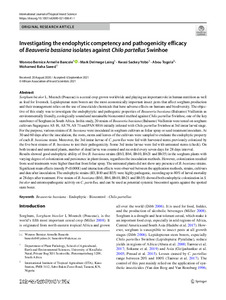| dc.contributor.author | Bancole, W.B.A. |
| dc.contributor.author | Laing, M. |
| dc.contributor.author | Yobo, K.S. |
| dc.contributor.author | Togola, A. |
| dc.contributor.author | Saeed, M.B. |
| dc.date.accessioned | 2021-11-29T10:56:54Z |
| dc.date.available | 2021-11-29T10:56:54Z |
| dc.date.issued | 2021 |
| dc.identifier.citation | Bancole, W.B.A., Laing, M.D., Yobo, K.S., Togola, A. & Saeed, M.B. (2021). Investigating the endophytic competency and pathogenicity efficacy of Beauveria bassiana isolates against Chilo partellus Swinhoe. International Journal of Tropical Insect Science, 1-13. |
| dc.identifier.issn | 1742-7584 |
| dc.identifier.uri | https://hdl.handle.net/20.500.12478/7290 |
| dc.description.abstract | Sorghum bicolor L. Moench (Poaceae) is a cereal crop grown worldwide and playing an important role in human nutrition as well as feed for livestock. Lepidopteran stem borers are the most economically important insect pests that affect sorghum production and their management relies on the use of insecticide chemicals that have adverse effects on humans and biodiversity. The objective of this study was to investigate the endophytytic and pathogenic properties of Beauveria bassiana (Balsamo) Vuillemin as environmentally friendly, ecologically sound and sustainable bioncontrol method against Chilo partellus Swinhoe, one of the key stemborer of Sorghum in South Africa. In this study, 20 strains of Beauveria bassiana (Balsamo) Vuillemin were tested on sorghum cultivars Sugargraze AS 18, AS 79, AS 71 and PAN 8816 initially infested with Chilo partellus Swinhoe at 3rd instar larval stage. For the purpose, various strains of B. bassiana were inoculated in sorghum cultivars as foliar spray or seed treatment inoculum. At 30 and 60 days after the inoculation, the roots, stems and leaves of the cultivars were sampled to evaluate the endophytic property of each B. bassiana strain. Moreover, the 3rd instar larvae of C. partellus were fed with harvested stems previously colonized by the five best strains of B. bassiana to test their pathogenicity. Some 3rd instar larvae were fed with untreated stems (check). On both treated and untreated plants, number of dead larva was counted and recorded every seven days for 28 days interval. Results showed good endophytic ability of five B. bassiana strains (Bb3, Bb4, Bb10, Bb21 and Bb35) in the sorghum plants with varying degree of colonization and persistence in plant tissues, regardless the inoculation methods. However, colonization resulted from seed treatments were higher than that from foliar spray. The untreated plants did not show any presence of B. bassiana strains. Significant main effects (mostly P<0.0001) and interaction effects were observed between the application methods, strains, cultivars and date after inoculation. The endophytic strains (B3, B10 and B35) were highly pathogenic, recording up to 80% of larval mortality at 28 days after treatment. Five strains of B. bassiana (Bb3, Bb4, Bb10, Bb21 and Bb35) showed both endophytic colonization in S. bicolor and entomopathogenic activity on C. partellus, and can be used as potential systemic biocontrol agents against the spotted stem borer. |
| dc.description.sponsorship | Organization for Women in Science for Developing world |
| dc.description.sponsorship | Plant Health Products (PHP), South Africa |
| dc.format.extent | 1-13 |
| dc.language.iso | en |
| dc.subject | Beauveria Bassiana |
| dc.subject | Endophytes |
| dc.subject | Biological Control |
| dc.subject | Chilo Partellus |
| dc.title | Investigating the endophytic competency and pathogenicity efficacy of Beauveria bassiana isolates against Chilo partellus Swinhoe |
| dc.type | Journal Article |
| cg.contributor.crp | Grain Legumes |
| cg.contributor.affiliation | University of KwaZulu- Natal |
| cg.contributor.affiliation | International Institute of Tropical Agriculture |
| cg.coverage.hub | Headquarters and Western Africa Hub |
| cg.researchtheme | Plant Production and Health |
| cg.identifier.bibtexciteid | BANCOLE:2021 |
| cg.isijournal | ISI Journal |
| cg.authorship.types | CGIAR and developing country institute |
| cg.iitasubject | Agronomy |
| cg.iitasubject | Biodiversity |
| cg.iitasubject | Disease Control |
| cg.iitasubject | Food Security |
| cg.iitasubject | Grain Legumes |
| cg.iitasubject | Plant Breeding |
| cg.iitasubject | Plant Diseases |
| cg.iitasubject | Plant Health |
| cg.iitasubject | Plant Production |
| cg.journal | International Journal of Tropical Insect Science |
| cg.notes | Published online: 07 Oct 2021 |
| cg.accessibilitystatus | Limited Access |
| cg.reviewstatus | Peer Review |
| cg.usagerightslicense | Copyrighted; all rights reserved |
| cg.targetaudience | Scientists |
| cg.identifier.doi | https://dx.doi.org/10.1007/s42690-021-00641-1 |
| cg.iitaauthor.identifier | Abou TOGOLA: 0000-0001-6155-8292 |
| cg.futureupdate.required | No |
| cg.contributor.acknowledgements | This study were made possible by a grant from the Organization for Women in Science for Developing world (OWSD) and research funds from Plant Health Products (PHP), South Africa. |

